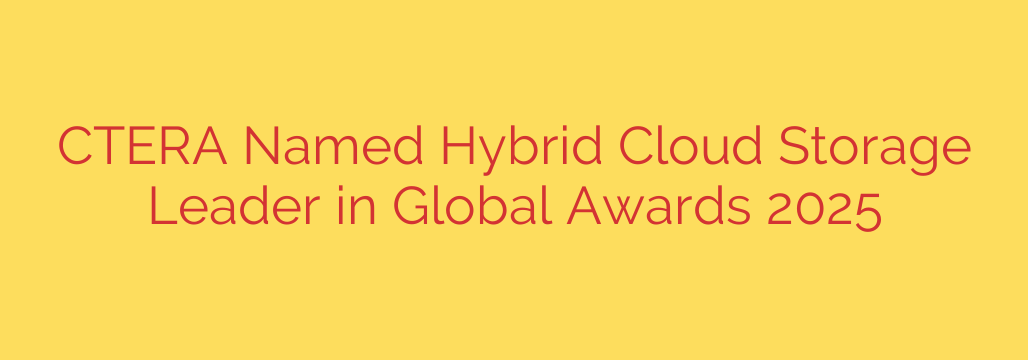
The Blueprint for Modern Data Management: What Defines a Leader in Hybrid Cloud Storage?
In today’s fast-paced digital landscape, data is more than just information—it’s the lifeblood of your organization. As businesses grapple with explosive data growth, distributed workforces, and the ever-present threat of cyberattacks, legacy storage systems are no longer sufficient. The strategic answer lies in hybrid cloud storage, a model that combines the security of on-premises infrastructure with the flexibility and scale of the public cloud.
Recently, industry experts have recognized a new standard for leadership in this critical field, highlighting solutions that go far beyond simple data storage. The defining characteristics of a top-tier hybrid cloud platform are now centered on intelligence, security, and efficiency, setting a clear benchmark for what organizations should demand from their IT infrastructure.
Ironclad Security and Ransomware Resilience
The most significant threat to enterprise data today is ransomware. A leading hybrid cloud storage solution must offer a multi-layered defense strategy. This begins with an architecture built on zero-trust principles, ensuring that no user or device is trusted by default. However, the true differentiator lies in proactive defense mechanisms.
Modern platforms provide immutable, undeletable snapshots of your data, creating a secure, time-stamped copy that ransomware cannot touch. In the event of an attack, this allows for near-instant recovery of entire file systems, turning a potentially catastrophic event into a manageable inconvenience. By integrating these robust security features directly into the storage fabric, businesses can protect their most critical asset—their data—without compromising on performance or accessibility.
AI-Powered Data Intelligence
Simply storing data is no longer enough. The future of data management is about understanding and leveraging it intelligently. Leading platforms are now integrating artificial intelligence and machine learning to provide deeper insights and automate critical functions.
Key capabilities include:
- AI-Driven Anomaly Detection: The system can proactively identify unusual file access patterns that may signal a budding ransomware attack or an insider threat, allowing IT teams to intervene before damage is done.
- Intelligent Data Classification: AI can automatically scan and tag sensitive data (like PII or financial records), ensuring it is stored in compliance with regulations like GDPR and CCPA.
- Predictive Analytics: By analyzing usage patterns, the platform can help optimize storage costs and forecast future capacity needs.
This level of intelligence is transforming raw data from a storage liability into a strategic advantage, enabling organizations to make smarter, data-driven decisions.
Seamless Edge-to-Cloud Integration
For organizations with remote offices, branch locations, or a distributed workforce, managing data across multiple sites is a major challenge. The hallmark of a premier hybrid cloud solution is its ability to create a unified global file system. This technology presents all of an organization’s data—whether it’s in a central data center, a remote office, or the public cloud—as a single, coherent namespace.
This approach eliminates data silos and ensures that users have fast, secure access to the files they need, regardless of their physical location. By caching frequently used files locally at the “edge” while tiering older data to the cloud, these systems deliver optimal performance without the need for expensive, redundant hardware at every site. The result is a unified, single source of truth for all enterprise data, boosting collaboration and productivity.
Demonstrable ROI and a Lower Total Cost of Ownership (TCO)
Finally, any leading technology must make financial sense. Top-tier hybrid cloud platforms are designed to consolidate outdated, complex IT infrastructure. By replacing traditional NAS filers, backup systems, and file collaboration tools with a single, software-defined platform, organizations can dramatically simplify management.
This consolidation delivers significant cost savings and a lower TCO by reducing hardware footprints, minimizing software license fees, and optimizing cloud egress costs. The ability to seamlessly tier data to the most cost-effective storage medium ensures that you only pay for high-performance storage when you truly need it.
Actionable Security Tips for Your Hybrid Cloud Strategy
As you evaluate storage solutions, prioritize platforms that offer a comprehensive security posture. Here’s what to look for:
- Demand Immutability: Ensure the solution can create undeletable snapshots. This is your last and best line of defense against ransomware.
- Verify Zero-Trust Architecture: Ask vendors how their system authenticates and authorizes every access request, not just those from outside the network.
- Prioritize Integrated Threat Detection: A platform that can actively monitor for and alert on suspicious activity is vastly superior to one that relies solely on external security tools.
- Audit for Compliance: Choose a solution that helps automate data classification and management to ensure you remain compliant with industry and regional regulations.
Ultimately, the leaders in hybrid cloud storage are no longer just vendors; they are strategic partners. They provide a resilient, intelligent, and efficient foundation that empowers businesses to protect their data, unlock its value, and confidently navigate the challenges of the modern digital world.
Source: https://datacenternews.asia/story/ctera-named-hybrid-cloud-storage-leader-in-2025-global-awards








